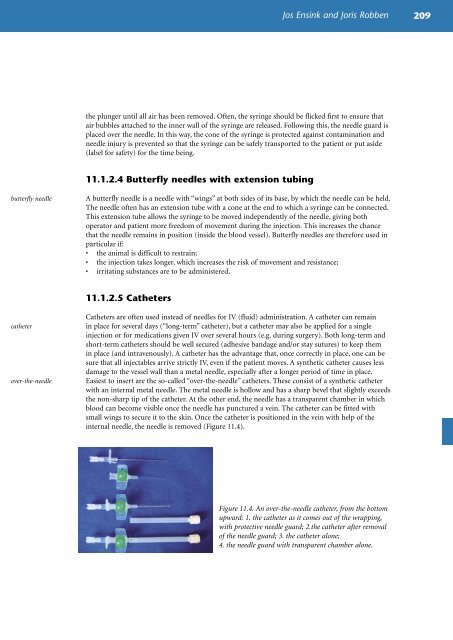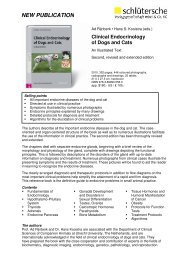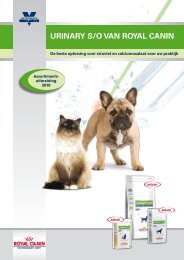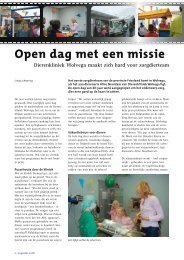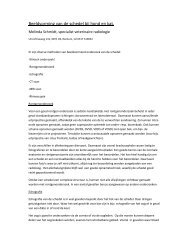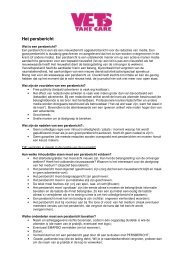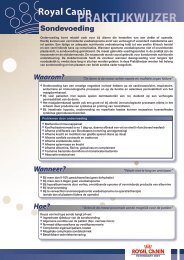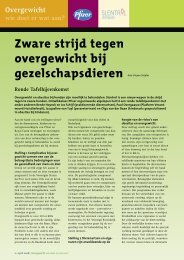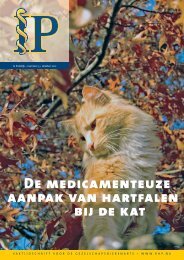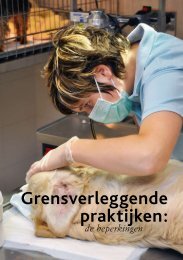Injection techniques for drug administration and methods of restraint
Injection techniques for drug administration and methods of restraint
Injection techniques for drug administration and methods of restraint
Create successful ePaper yourself
Turn your PDF publications into a flip-book with our unique Google optimized e-Paper software.
utterfly needle<br />
catheter<br />
over-the-needle<br />
the plunger until all air has been removed. Often, the syringe should be flicked first to ensure that<br />
air bubbles attached to the inner wall <strong>of</strong> the syringe are released. Following this, the needle guard is<br />
placed over the needle. In this way, the cone <strong>of</strong> the syringe is protected against contamination <strong>and</strong><br />
needle injury is prevented so that the syringe can be safely transported to the patient or put aside<br />
(label <strong>for</strong> safety) <strong>for</strong> the time being.<br />
11.1.2.4 Butterfly needles with extension tubing<br />
A butterfly needle is a needle with “wings” at both sides <strong>of</strong> its base, by which the needle can be held.<br />
The needle <strong>of</strong>ten has an extension tube with a cone at the end to which a syringe can be connected.<br />
This extension tube allows the syringe to be moved independently <strong>of</strong> the needle, giving both<br />
operator <strong>and</strong> patient more freedom <strong>of</strong> movement during the injection. This increases the chance<br />
that the needle remains in position (inside the blood vessel). Butterfly needles are there<strong>for</strong>e used in<br />
particular if:<br />
• the animal is difficult to restrain;<br />
• the injection takes longer, which increases the risk <strong>of</strong> movement <strong>and</strong> resistance;<br />
• irritating substances are to be administered.<br />
11.1.2.5 Catheters<br />
Jos Ensink <strong>and</strong> Joris Robben 209<br />
Catheters are <strong>of</strong>ten used instead <strong>of</strong> needles <strong>for</strong> IV (fluid) <strong>administration</strong>. A catheter can remain<br />
in place <strong>for</strong> several days (“long-term” catheter), but a catheter may also be applied <strong>for</strong> a single<br />
injection or <strong>for</strong> medications given IV over several hours (e.g. during surgery). Both long-term <strong>and</strong><br />
short-term catheters should be well secured (adhesive b<strong>and</strong>age <strong>and</strong>/or stay sutures) to keep them<br />
in place (<strong>and</strong> intravenously). A catheter has the advantage that, once correctly in place, one can be<br />
sure that all injectables arrive strictly IV, even if the patient moves. A synthetic catheter causes less<br />
damage to the vessel wall than a metal needle, especially after a longer period <strong>of</strong> time in place.<br />
Easiest to insert are the so-called “over-the-needle” catheters. These consist <strong>of</strong> a synthetic catheter<br />
with an internal metal needle. The metal needle is hollow <strong>and</strong> has a sharp bevel that slightly exceeds<br />
the non-sharp tip <strong>of</strong> the catheter. At the other end, the needle has a transparent chamber in which<br />
blood can become visible once the needle has punctured a vein. The catheter can be fitted with<br />
small wings to secure it to the skin. Once the catheter is positioned in the vein with help <strong>of</strong> the<br />
internal needle, the needle is removed (Figure 11.4).<br />
Figure 11.4. An over-the-needle catheter, from the bottom<br />
upward: 1. the catheter as it comes out <strong>of</strong> the wrapping,<br />
with protective needle guard; 2.the catheter after removal<br />
<strong>of</strong> the needle guard; 3. the catheter alone;<br />
4. the needle guard with transparent chamber alone.


